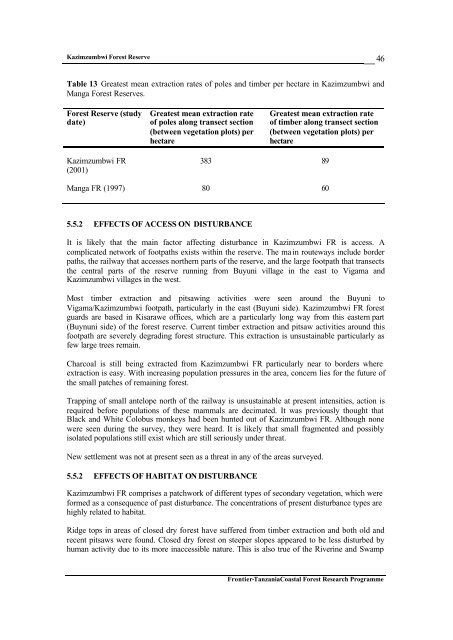Frontier Tanzania Environmental Research REPORT 110 ...
Frontier Tanzania Environmental Research REPORT 110 ...
Frontier Tanzania Environmental Research REPORT 110 ...
You also want an ePaper? Increase the reach of your titles
YUMPU automatically turns print PDFs into web optimized ePapers that Google loves.
Kazimzumbwi Forest Reserve<br />
46<br />
Table 13 Greatest mean extraction rates of poles and timber per hectare in Kazimzumbwi and<br />
Manga Forest Reserves.<br />
Forest Reserve (study<br />
date)<br />
Greatest mean extraction rate<br />
of poles along transect section<br />
(between vegetation plots) per<br />
hectare<br />
Greatest mean extraction rate<br />
of timber along transect section<br />
(between vegetation plots) per<br />
hectare<br />
Kazimzumbwi FR<br />
(2001)<br />
383 89<br />
Manga FR (1997) 80 60<br />
5.5.2 EFFECTS OF ACCESS ON DISTURBANCE<br />
It is likely that the main factor affecting disturbance in Kazimzumbwi FR is access. A<br />
complicated network of footpaths exists within the reserve. The ma in routeways include border<br />
paths, the railway that accesses northern parts of the reserve, and the large footpath that transects<br />
the central parts of the reserve running from Buyuni village in the east to Vigama and<br />
Kazimzumbwi villages in the west.<br />
Most timber extraction and pitsawing activities were seen around the Buyuni to<br />
Vigama/Kazimzumbwi footpath, particularly in the east (Buyuni side). Kazimzumbwi FR forest<br />
guards are based in Kisarawe offices, which are a particularly long way from this eastern part<br />
(Buynuni side) of the forest reserve. Current timber extraction and pitsaw activities around this<br />
footpath are severely degrading forest structure. This extraction is unsustainable particularly as<br />
few large trees remain.<br />
Charcoal is still being extracted from Kazimzumbwi FR particularly near to borders where<br />
extraction is easy. With increasing population pressures in the area, concern lies for the future of<br />
the small patches of remaining forest.<br />
Trapping of small antelope north of the railway is unsustainable at present intensities, action is<br />
required before populations of these mammals are decimated. It was previously thought that<br />
Black and White Colobus monkeys had been hunted out of Kazimzumbwi FR. Although none<br />
were seen during the survey, they were heard. It is likely that small fragmented and possibly<br />
isolated populations still exist which are still seriously under threat.<br />
New settlement was not at present seen as a threat in any of the areas surveyed.<br />
5.5.2 EFFECTS OF HABITAT ON DISTURBANCE<br />
Kazimzumbwi FR comprises a patchwork of different types of secondary vegetation, which were<br />
formed as a consequence of past disturbance. The concentrations of present disturbance types are<br />
highly related to habitat.<br />
Ridge tops in areas of closed dry forest have suffered from timber extraction and both old and<br />
recent pitsaws were found. Closed dry forest on steeper slopes appeared to be less disturbed by<br />
human activity due to its more inaccessible nature. This is also true of the Riverine and Swamp<br />
<strong>Frontier</strong>-<strong>Tanzania</strong>Coastal Forest <strong>Research</strong> Programme

















